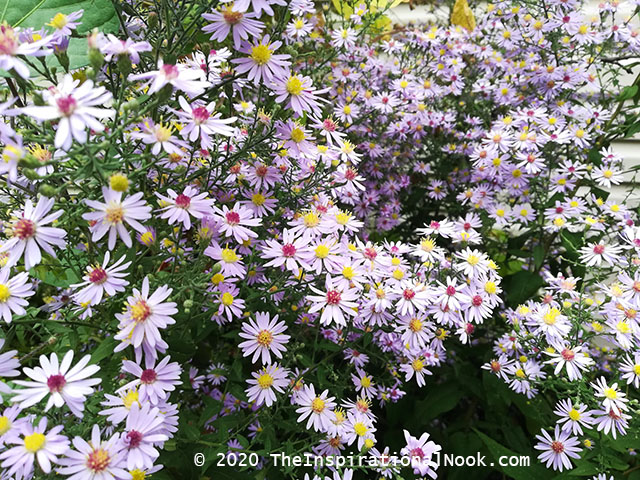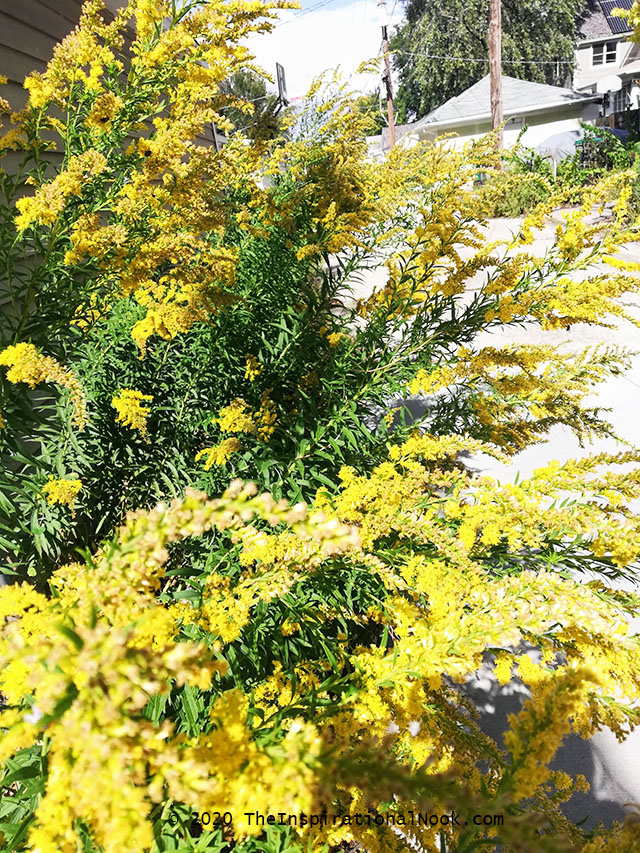My Perennial Garden | September Stars
Hello again and welcome to my garden! September was a month par excellence. Everything was alive and well in our garden with both the flora and fauna working overtime to impress us. Our late summer-early Fall perennials were in full bloom and never looked better.
I've decided to showcase my Top 4 Perennial Garden Stars this September.
1. Smooth Asters
Aster laevis, a member of the Asteraceae family
The word "aster" is derived from the ancient Greek word meaning "star", because of it's shape. And did it live up to its name or what, this year? They truly were one of my September stars!
These little daisy-like flowers, with their profusion of pale mauve flowers with their yellow centers, turning red later in the season, were a star performer. They started off as leggy plants earlier in the year. But once the flower buds came in, they mounded up nicely into 3 ft' tall plants and all you can could see was a sea of light mauve flowers.
Some years, I pinch back asters twice in the growing season (before the flowering buds come in), to promote a shorter plant and bushier growth. A native, prairie plant that grows well in the Mid-west, asters do best in full sun, are low maintenance and should flower well into the cooler Fall season in October.
Great companion plants for asters are goldenrods. These bloom at the same time of the year and yellow golden rods complement the lavender-blue asters beautifully.
Which brings me to my next showstopper...
2. Goldenrod
Solidago canadensis, a member of the Asteraceae family.
It was 'Goldenrods Gone Wild' this year! These 6ft. tall plants with their bright yellow golden plumes, waving in the breeze, really were a sight to behold. Native to our our mid-western prairie soil, they do best in blazing sun and flower in later summer. Most of my golden rods bloom on the sunny side of my garage along the alley. So, while I can't see them as easily, I'm sure they delighted many a driver who motored through our alley.
The bees just absolutely loved them, so I needed to go out it in the late evenings, after the bees had subsided, to take cuttings for my vase. They're a wonderful, long-lasting cut flower and looked absolutely gorgeous sitting on my dining table.
There's a common misconception that goldenrod pollen causes allergies. But, that's not true. It's other common allergy causing plants that bloom around the same time as goldenrods that are the culprits. Goldenrod pollen is very sticky (designed to easily stick to the legs and bodies of pollinators) and doesn't fly around easily. However, do be prepared to find a dusting of pollen around cut flowers that are aging or drying out in your flower vase.
My tall goldenrods tend to get a bit floppy as their blooming heads becoming heavier. Sometimes, during the growing season, I pinch back their tips a couple of times. This reduces their height, but cause them to bloom a couple of weeks later than normal with not as stunning a floral display.
3. Lemon Lace
Fallopia baldschuanica of the Polygonaceae family
This twining vine looks as delightful as it sounds. This quick growing vine, in it's third growing season in my yard, scrambled up my fence early in the year, sending out its chartreuse colored, heart-shaped leaves on red stems. It has really brightened up my garden. And once it started flowering in early August, the profusion of frothy, white, delicate flowers dancing atop my fence was really beautiful.
It grows vigorously and flowers profusely in full sun. However, in part-shade to full shade its growth is slower, the leaves are darker and the flowers limited.
It tends to grow less vigorously than it's cousin, the aggressive Silver lace vine (Fallopia aubertii), that has received the reputation of being an invasive species.
Even when Lemon Lace is not in bloom, it's a real winner. I've planted a Prunus cistena (Purple Leaf Sand cherry) in front of my Lemon Lace. So, the dark purple leaves of the Prunus are the perfect foil for the lemon-green leaves of the Lemon Lace.
4. Sweet Autumn Clematis
Clematis terniflora
And my final star that started blooming in early September was my Sweet Autumn Clematis vine. Scrambling carelessly over my fence, covered in starry, white, fragrant flowers, it was an absolutely gorgeous sight to see these masses of white flowers. A prolific bloomer in full-sun.
As September turns to October, the flowers on my Sweet Autumn Clematis are fading away into attractive, silvery, fluffy seed heads.
I have Sweet Autumn Clematis planted against my trellis fence, where it scrambles up with ease in Spring. I also planted some in a pot and placed it on my deck. With a little support, it scampered up my deck where it intermingled with the pots of red geraniums in my deck baskets, forming an impromptu live flower arrangement.
I couldn't be happier with my four September Stars. Here's what they look like together. Sweet Autumn Clematis in the foreground, Lemon Lace and Sweet Autumn Clematis dripping off the fence on the left and goldenrods sandwiched between the Sand cherry and Limelight hydrangea.
I can't wait to see what October brings. Come back to find out.
In the meantime, check out:
My Perennial Garden | A Seasonal Kaleidoscope (One spot in my garden viewed in different seasons)




